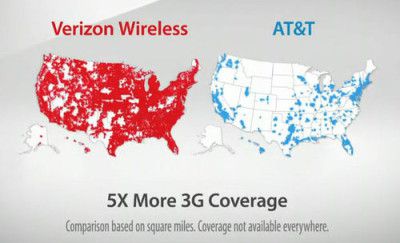From our front-page news:
There are times when advertising can be extremely effective at getting the point across, and one way to accomplish this is to single out a competitor and attempt at proving to the general public that you're company is better than theirs. For the past few years, we've seen this with Apple, which has continually poked fun at Microsoft's Windows from every possible angle. Today, it's not computer companies who are at each other, but rather cell service providers.
Recently, Verizon launched a campaign to show just how incredible its 3G coverage is, and during the commercial, a map of both its own, and also AT&T's coverage is shown on the US map. In it, Verizon has so much coverage area, that it appears that it has about 9x or 10x as much coverage area. In some states, AT&T doesn't seem to offer 3G support at all. This alone isn't so much the problem, though.
According to AT&T and its lawyers, the map is confusing to the regular consumer, who doesn't understand that 3G != general cell service. The company believes that when consumers see this map, that they will be lead to believe that AT&T has absolutely horrid cell phone support, when in truth, the map is singling out 3G and 3G alone. On one hand, I can understand why AT&T would be concerned, but on the other, the commercial is very clear about the fact that it's talking about 3G, and nothing else.
The other question is whether or not the maps are at all accurate even where 3G is concerned. Could AT&T really be offering absolutely no service in most of middle America? I'm not familiar with AT&T or its 3G service, but it would seem a little odd to have no support whatsoever in certain states. Whether AT&T has a hope of winning its case is yet to be seen. Verizon seems very clear in its ad, but a judge might not see it that way.

Consumers are interpreting the white or blank space on the maps to mean that AT&T customers who are not in an AT&T "3G" coverage area have no wireless coverage whatsoever, and therefore have no ability to use their wireless devices for any purposes in vast areas of the country. This interpretation is not surprising as Verizon, in its own coverage maps, uses white space to inform customers that no coverage of any kind exists.
Source: Gizmodo
Recently, Verizon launched a campaign to show just how incredible its 3G coverage is, and during the commercial, a map of both its own, and also AT&T's coverage is shown on the US map. In it, Verizon has so much coverage area, that it appears that it has about 9x or 10x as much coverage area. In some states, AT&T doesn't seem to offer 3G support at all. This alone isn't so much the problem, though.
According to AT&T and its lawyers, the map is confusing to the regular consumer, who doesn't understand that 3G != general cell service. The company believes that when consumers see this map, that they will be lead to believe that AT&T has absolutely horrid cell phone support, when in truth, the map is singling out 3G and 3G alone. On one hand, I can understand why AT&T would be concerned, but on the other, the commercial is very clear about the fact that it's talking about 3G, and nothing else.
The other question is whether or not the maps are at all accurate even where 3G is concerned. Could AT&T really be offering absolutely no service in most of middle America? I'm not familiar with AT&T or its 3G service, but it would seem a little odd to have no support whatsoever in certain states. Whether AT&T has a hope of winning its case is yet to be seen. Verizon seems very clear in its ad, but a judge might not see it that way.

Consumers are interpreting the white or blank space on the maps to mean that AT&T customers who are not in an AT&T "3G" coverage area have no wireless coverage whatsoever, and therefore have no ability to use their wireless devices for any purposes in vast areas of the country. This interpretation is not surprising as Verizon, in its own coverage maps, uses white space to inform customers that no coverage of any kind exists.
Source: Gizmodo
